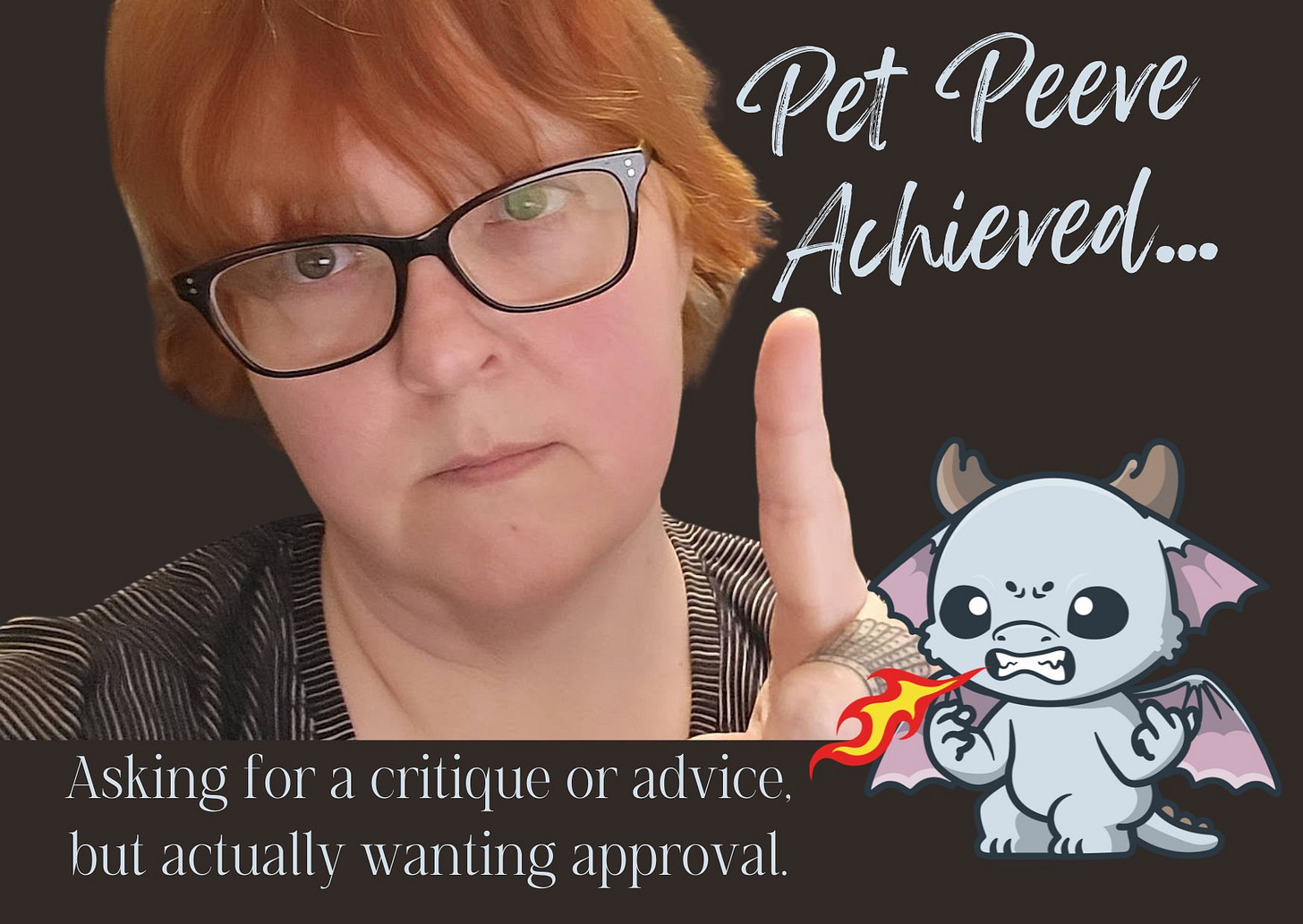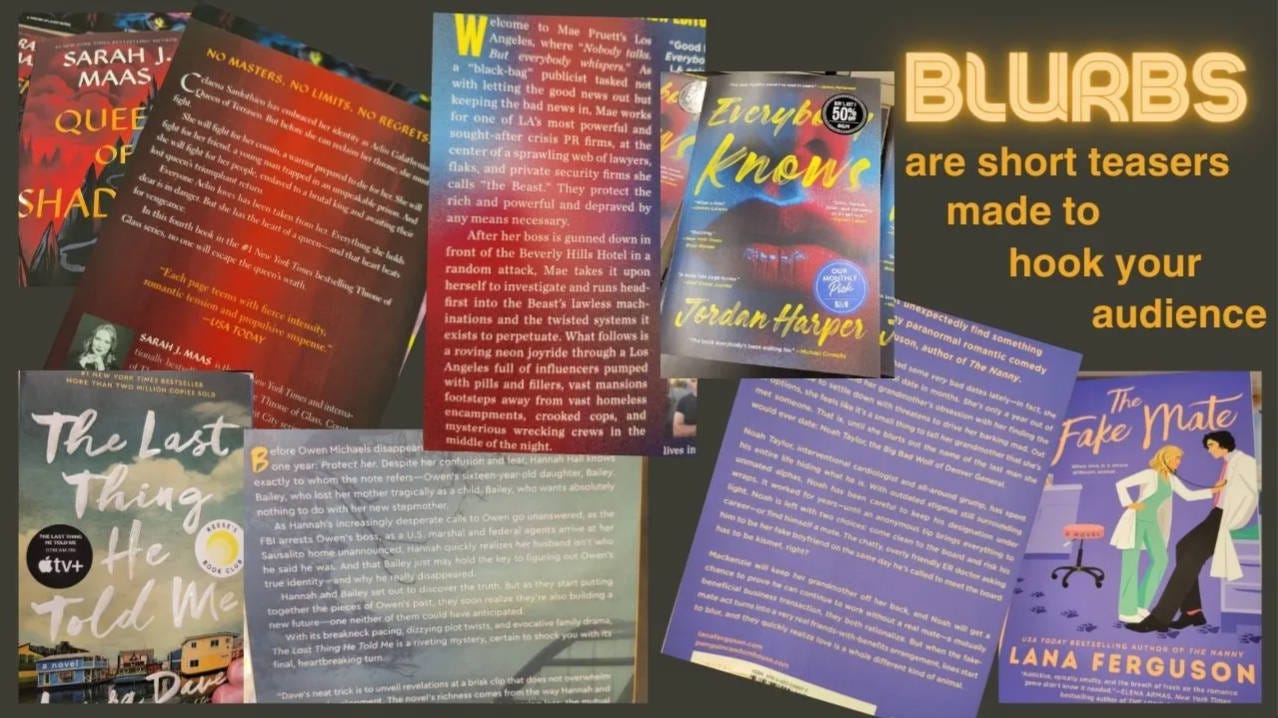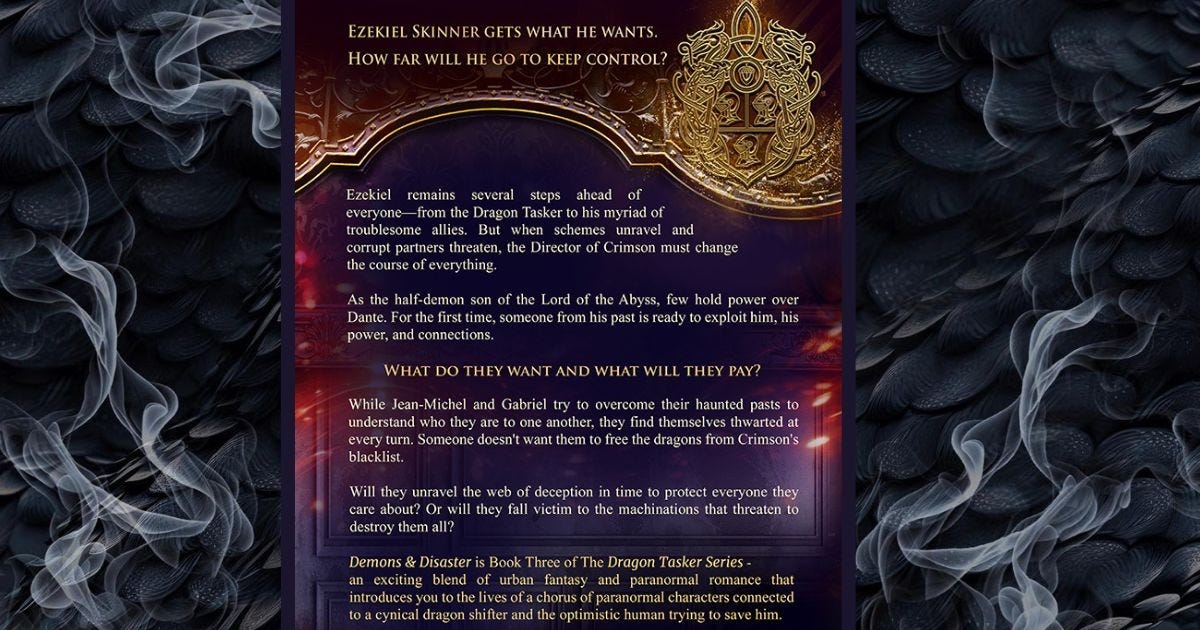Your Whole Ass Plot is Showing!
How to intrigue and tease your audience without showing them everything...
That’s how I felt. The cat’s face says it all. Annoyance. And that annoyance was two-fold.
For one, someone asked for advice on their blurb.
I just despise it when someone asks for — the truth, an honest opinion, advice, or a critique — but they don’t really want that. It’s a pet-peeve of mine.
Now, I don’t know this author personally. I’m not sure they really wanted advice. They may have just wanted permission to do as they pleased. They may have wanted a pat on the back. All I could go by was what they asked for.
And that leads me to the second part of my annoyance. People were giving this person poor advice rather than critiquing their blurb. They were petting the original poster as if I and the others who responded similarly were attacking. The poster who asked for this feedback had not been attacked, nor had anyone been rude. Yet…
I need to add — this is my opinion — and yes, everyone has one. But also in my opinion, if you ask me for a critique, at least consider it as worthy advice before just dismissing it because it’s simply not what you want to hear. I don’t take every piece of advice offered to me. However, I consider all of it, because it usually comes from a good place.

I want people to succeed! If I were to only give positive feedback when honest feedback is what you asked for, I’m doing you a disservice. For instance, I beta read for people. If I read your book and not make any comments on it other than, “This was great! Thumbs up!” what good am I as a beta reader?
When you ask for advice or ask for someone to critique something, expect honesty and proper feedback. If you cannot take this, grow a thicker skin or consider a different business. Because feedback from other writers helps your writing thrive. That being said, let me set the scene.
The blurb’s the word…
I’m a member of several writing/writers groups online. In one of them, a would-be writer was posting her book blurb and asking if it was good or if it needed work, and what advice anyone might give her.
My advice was simple.
What I see here is an outline of everything you have planned for your protagonist. Maybe you should just tease scenarios instead of letting your audience know everything up front. If you only touch on the scenarios rather than going into detail, you have a winner.
Well, you’d have thought it was a slap to this person’s face! Other writers came to her defense (she honestly didn’t need defending — she had asked for advice and several of us gave it). The conversation more or less degenerated into a pity party followed by other writers telling her that she should write her blurb any darn way she pleased. That creating an outline of things that would happen in her book and using it as her blurb was perfectly fine. She shouldn’t let us negative Nellies make her feel bad.
When did giving advice that was asked for turn into being negative? And in what world is providing a chapter-by-chapter summary the same as a book blurb? What the f…?
So what does Rachel do? She second guesses herself. She goes online and does some research. Then, she goes to the bookstore to do more research.

So I began looking over blurbs both at the bookstores I went to and also online. And do you know what I found? Most books give away very little of what is going to happen in the book. If they give anything away, it’s just enough to wet the readers’ appetites.
A blurb should get a reader to want to purchase the book. If they already know step-by-step what is going to happen except the actual climax…why buy it?
When I saw people using the “outline — for — blurb” formula, it was usually an indie author. From what I could tell during my research, these authors are catering to a very specific reader. I feel like they are missing out on other readers because of it. Not only that, I also think they wouldn’t lose any readers by shifting their blurb format. I’m not going to suggest it, because they didn’t ask.
What is a blurb?
Now, it might be explained as a “persuasive summary” of a creative work, but it is also meant to be non-exhaustive and short. As an author, the temptation is to explain every twist and turn in your book-baby, because to you, it’s all important. However, you honestly should just touch on the most important features of the book and tease the rest.
Writing a book blurb can be aggravating and difficult. Why? It took you probably over 50,000 words to explain your story and now you’re expected to explain it in under 500 — sometimes under 300 words?
Here’s what helped lift the weight from my shoulders when I was struggling with writing my very first blurb. You do not need to explain your book in that amount of space. You simply need to hook your readers in that amount of space.
There’s a difference!

Think about those old movie trailers — the Movie Trailer Guy — he gave us a good idea of what a blurb should be. Or at least, he voiced them. Unfortunately for us, we don’t have his wonderful delivery system, so we have to come up with the correct balance all by ourselves.
Luckily, there are plenty of people willing to be mentors out there in the writersphere — and most of them believe in #authorshelpingauthors.
If you care for my example, I have no issue sharing. I usually keep space for a tagline (which is a catchy hook at the beginning of the blurb that usually stands out from the rest). Otherwise, my standard blurb outline for my urban fantasy/paranormal romance goes as follows:
Optional: Touch on or describe the setting — especially if this is important to the plot.
2. Intro of the protagonist. Brief description of their story at present. Perhaps a question the character is trying to solve or something to convey motivation.
3. Intro of secondary protagonist. Brief description of their story at present. Perhaps a question the character is trying to solve or something to convey motivation.
4. Intro of a plot situation or an antagonist that will affect everyone. This is where you need to give a bit of the conflict.
5. The stakes both protagonists face because of this plot, this character, or both.
6. Last — Reiterate the conflict to overcome. Ask questions the audience should want the answers to.
Also Optional: Separate from the blurb but at the end of my description I might add a bit more information. Especially if this is a series, I will include the placement of this book within the series, along with a quick series overview. I may also place trigger warnings or trope listings here.
Keep in mind not to be too vague in your descriptions, but also, don’t give away too many details. I only hint at the rising action. I don’t give away any twists. And I definitely do not mention the climax or resolution in any of them. I may ask a question that hints at things to come — but I want my audience to work for the details. Details are treasures, like good candy for the readers’ sweet tooth.
Another suggestion — blurbs may differ depending on genre. I would suggest going to your comparable books and take note of how they do it.
Also, if you wrote a book in first person you can have a third person style blurb or… you can have the characters explain things in the blurb in first person. I like this method, because it tells me (without actually saying it) that the book is likely written in first person. Sometimes, this style can actually bring your reader closer to the characters before they even open the book.

Your blurb is essentially a sales pitch — and if you don’t hook your reader quick enough, they’ll put the book down and reach for the next one in the pile.
Unlike the sales pitch for a physical item, you don’t want to give everything away with your blurb. You want the reader curious enough to want to pick up that book and read more.
Remember those movie trailers I mentioned? Think how excited you might be after the trailer! You get an anticipation rush about what else there is to come! You get out of your comfy home, buy the tickets, popcorn, and soda, then deal with the crowd. How disappointed would you be if you realized that the best parts of the movie were in the trailer?
If you want more than my opinion on book blurbs, that’s fair. I can recommend authors like Abbie Emmons, Sarra Cannon, Brittany Wang, and Alexa Donne as folks I have gotten good advice from concerning this subject. You can look up author programming about it. Even Masterclass gives a great rundown of how to create a book blurb.
Just please, for the love of all that is King, don’t write a summary or outline of the novel and call it a blurb!
New pet-peeve achieved!
Want more help? Check out my How to Blurb… the Workbook and look on my social media for any authorly events I’ll be presenting at!
This article was originally published in Long. Sweet. Valuable. on Medium - where I have a list of articles about Writing and Productivity, should you be interested.




